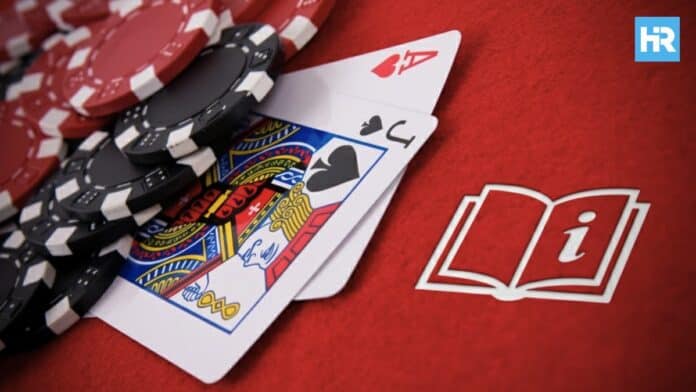The decision of whether to hit or stand represents the most fundamental choice facing players at blackjack tables worldwide.
While basic strategy charts provide mathematically optimal solutions for every scenario, memorizing complex tables can overwhelm casual players seeking practical guidance for everyday situations.
Hard-hand decisions, in particular, generate the most confusion among players because these hands lack the flexibility of soft totals and often involve borderline mathematical situations where minor rule variations can significantly affect optimal strategy. Understanding the core principles behind these decisions, rather than simply memorizing charts, enables players to make better choices even when they can’t recall every specific scenario.
Understanding Hard Hands vs Soft Hands in Blackjack
The distinction between hard and soft hands forms the foundation of blackjack strategy, affecting not only when to hit and when to stand in blackjack, but also doubling and splitting decisions.
Defining Hard Hands
A hard hand contains either no aces or counts any aces as one point to avoid busting. These hands present fixed values that cannot be adjusted downward if additional cards would cause the total to exceed 21. For example, a hand containing 10-6 represents a hard 16, as does a hand with Ace-5-10, where the ace must count as one.
Hard hands create more restrictive decision-making scenarios because players cannot adjust their hand values after receiving additional cards. This inflexibility makes mathematical precision more crucial for optimal play.
Soft Hand Flexibility
Conversely, a soft hand contains at least one ace, counted as 11 points, providing flexibility when drawing additional cards. A soft 17 (Ace-6) can receive any card without busting because the ace can convert from 11 to one if necessary.
This flexibility makes soft hands generally more advantageous than hard hands of equivalent value, explaining why many blackjack hard totals require more conservative play compared to their soft counterparts.
Core Hard Hand Strategy Principles in Blackjack
A successful hard hand strategy relies on understanding the mathematical relationships between player totals, dealer upcard strength, and bust probabilities rather than memorizing isolated decisions. This is true no matter which online casino sites you end up using.
The Bust Factor
Hard hands valued at 12 through 16 create the most challenging decisions because these totals can bust with any ten-valued card. Since ten-valued cards (10, Jack, Queen, King) comprise approximately 30% of the deck, players holding these totals face significant bust risks when hitting.
However, standing on these totals against strong dealer upcards often produces worse long-term results than accepting bust risks, as dealers holding strong cards frequently complete hands valued at 17 or higher.
Dealer Bust Probabilities
Understanding dealer bust frequencies helps explain optimal hard hand strategy. Dealers showing small cards (2 through 6) bust approximately 35-42% of the time, making standing more attractive for marginal player hands. Dealers showing large cards (7 through Ace) complete strong hands more frequently, requiring more aggressive player action.
These bust probabilities form the mathematical foundation for most hard-hand decisions, explaining why strategy changes dramatically based on the dealer’s upcard strength.
Specific Hard Hand Scenarios
Several everyday hard-hand situations generate consistent confusion among players, making these scenarios worth examining in detail. You can use these strategies at international gaming platforms, no matter which blackjack variant you are playing.
The 12 vs 2 Hit or Stand Decision
One of the most debated decisions in blackjack involves hitting or standing with a hard 12 against a dealer’s 2. A basic strategy dictates hitting in this scenario, although the mathematical edge is tiny.
Standing on 12 vs 2 results in an expected loss of approximately 25.3 cents per dollar wagered, while hitting results in an anticipated loss of about 25.0 cents per dollar. This tiny difference explains why many players feel comfortable standing in this situation, particularly in games with favorable rules or when counting cards indicates a deck with a high concentration of tens.
The slight mathematical difference also means that rule variations can occasionally reverse this decision, making 12 vs 2 one of the most rule-dependent scenarios in basic strategy.
13 vs 2 Blackjack Strategy
The 13 vs 2 blackjack situation presents a clearer decision than 12 vs 2, with basic strategy strongly favoring standing. The additional point in the player’s favor reduces bust risk enough to make standing mathematically superior by a more significant margin.
Players should stand on 13 vs 2 in virtually all rule variations, as the improved starting position makes this decision more robust than the marginal 12 vs 2 case.
16 vs 10 Blackjack Dilemma
The 16 vs 10 blackjack scenario represents one of the worst situations in the game, with both hitting and standing producing negative expected values. The basic strategy recommends hitting, accepting the high bust probability, because standing virtually guarantees losing to a strong dealer hand.
Against a dealer 10, standing on 16 loses approximately 54% of the time, while hitting loses about 52% of the time. Although both options are suboptimal, hitting provides slightly better long-term results, albeit with an uncomfortable bust frequency.
This decision becomes more complex in surrender-allowed games, where giving up half the bet often proves superior to either hitting or standing.
15 vs 10 Blackjack Analysis
Similar to the 16 vs 10 situation, the 15 vs 10 blackjack situation favors hitting despite high bust risks. The mathematical advantage of hitting becomes more pronounced with 15 vs 10 compared to 16 vs 10, as the lower starting total provides slightly more flexibility.
Players should hit 15 vs 10 in virtually all scenarios, as standing produces worse results than accepting bust risks.
Hard 17 Blackjack Rules
Hard 17 blackjack strategy presents one of the clearest decisions in the game: always stand. With a total of 17, players have achieved a competitive hand that wins against dealer busts and ties against dealer 17s.
Hitting hard 17 produces immediate busts with any card valued at 5 or higher, representing approximately 62% of remaining cards. This enormous bust risk makes standing mathematically superior by a wide margin, regardless of dealer upcard.
Blackjack Rule Variations and Their Impact
Different rule variations can affect the optimal hard hand strategy, particularly in borderline mathematical situations.
Dealer Hits Soft 17 (H17) vs Stands on Soft 17 (S17)
The H17 rule, where dealers hit soft 17, slightly increases dealer final averages and affects some hard hand decisions. In H17 games, the dealer’s improved performance makes hitting somewhat more attractive for marginal player hands.
However, these effects primarily influence soft hand strategy and surrender decisions rather than dramatically changing hard hand play. Most fundamental hard hand decisions remain consistent across H17 and S17 games.
Multiple Deck Effects
Single-deck games provide slightly more favorable conditions for players, occasionally affecting borderline hard hand decisions. The increased probability of specific cards in single-deck play can make standing more attractive in close mathematical situations.
However, these effects are typically minor and don’t justify major strategy modifications for recreational players. The fundamental hard hand principles remain consistent across different deck numbers.
Memory Techniques for Hard Hand Strategy in Blackjack
Rather than memorizing complex hit or stand chart details, players benefit from understanding logical patterns that govern hard hand decisions.
The “Weak Dealer” Principle
Against weak dealer upcards (2 through 6), players should stand on hard 12 and above, accepting the risk of losing to completed dealer hands in exchange for capitalizing on high dealer bust frequencies.
This principle handles the majority of hard hand decisions against weak dealer cards, requiring only minor exceptions for specific rule variations or card counting situations.
The “Strong Dealer” Rule
Against strong dealer upcards (7 through Ace), players should hit hard 16 and below, accepting bust risks to avoid almost certain losses against likely dealer totals of 17 or higher.
Combined with the weak dealer principle, this rule covers approximately 80% of hard hand situations with easily remembered logic.
Boundary Cases
The most challenging memory situations involve hands like 12 vs 2-3, where the mathematical advantage is slight and rule variations can significantly affect the optimal strategy. For these borderline cases, players should remember that conservative approaches (such as standing) rarely cost more than a few tenths of a percent in expected value.
Understanding that these decisions have minimal long-term impact helps players avoid overthinking situations where a perfect strategy provides only marginal advantages.
Advanced Considerations for Blackjack Players
Beyond basic hard hand strategy, several factors can influence optimal decisions for experienced players.
Composition Dependency
The specific cards that comprise hard hands can occasionally affect optimal strategy. For example, a hard 16 composed of 10-6 faces slightly different probabilities than a 16 consisting of 8-8, though these differences rarely justify strategy changes for basic strategy players.
Card counters may adjust hard hand strategy based on remaining deck composition, but these adjustments require significant expertise and practice to implement correctly.
Tournament Considerations
Tournament blackjack introduces betting strategy elements that can override basic hard hand strategy. Players trailing in tournaments may need to hit hands they would normally stand on, while players protecting leads might stand in situations where hitting would be mathematically superior.
These tournament-specific adjustments require understanding both basic strategy foundations and situational tournament tactics.
Common Hard Hand Mistakes When Playing Blackjack
Several errors consistently appear among players learning hard hand strategy, often stemming from emotional rather than mathematical decision-making.
Fear of Busting
Many players stand too frequently on hard hands, such as 15 and 16, allowing fear of busting to override mathematical logic. While busting feels worse than losing to a dealer’s made hand, the long-term cost of overly conservative play exceeds the psychological comfort of avoiding busts.
Understanding that both outcomes result in a loss of the bet helps players focus on choosing the option with better mathematical expectations.
Misunderstanding Dealer Probabilities
Players often overestimate the dealer’s bust frequencies, particularly against medium-strength dealer upcards, such as 7 and 8. This misunderstanding leads to excessive standing on hard hands that should be hit for optimal results.
An accurate understanding of dealer completion rates helps players make more rational decisions about accepting bust risks.
Bankroll Considerations in Online Blackjack
Hard hand strategy intersects with bankroll management through variance and risk tolerance considerations.
Variance Impact
Hitting hard hands increases short-term variance compared to standing, as bust outcomes result in immediate losses, while successful hits can lead to wins. Players with limited bankrolls may prefer slightly more conservative approaches that reduce variance, even if it means sacrificing some expected value. Modern platforms, including cryptocurrency betting sites, often provide faster deposit and withdrawal options that can help players manage their bankroll more effectively during extended blackjack sessions.
Risk of Ruin
For players with small bankrolls relative to their betting levels, the increased variance from the optimal hard hand strategy might increase the risk of ruin enough to justify minor strategy modifications toward more conservative play.
However, these adjustments should be minimal and temporary, as proper bankroll sizing provides better long-term solutions than a suboptimal strategy.
Blackjack for Beginners: Practice and Implementation
Mastering hard hand strategy requires systematic practice and gradual implementation of proper techniques.
Structured Learning
Players should begin by mastering the most frequently occurring hard hand decisions: standing on hard 17 and above, hitting hard 11 and below, and applying the weak dealer/strong dealer principles for totals in between.
Once these fundamental concepts become automatic, players can refine their strategy with borderline cases and rule-specific adjustments.
Error Tracking
Keeping records of hard-hand decisions and their outcomes helps players identify areas where they consistently deviate from basic strategy. While short-term results don’t validate or invalidate strategy decisions, tracking errors helps maintain focus on proper technique.
Technology and Hard Hand Strategy in Blackjack
Modern technology offers various tools for learning and practicing hard hand strategy; however, understanding the underlying principles remains more valuable than relying on technological dependence.
Strategy Trainers
Computer programs and mobile applications can drill hard-hand scenarios repeatedly, helping players develop automatic responses to everyday situations. These tools are most effective when used in conjunction with a conceptual understanding, rather than relying on rote memorization. Modern mobile betting sites often include built-in strategy trainers and practice modes that allow players to refine their hard hand decisions without risking real money.
Simulation Software
Advanced players can utilize simulation software to test how rule variations impact their hard hand strategy, although this level of analysis typically exceeds the needs of most recreational players.
Hit or Stand in Blackjack – Final Words
Mastering hard hand strategy in blackjack requires understanding the mathematical principles that drive optimal decisions rather than simply memorizing strategy charts. The fundamental concepts of dealer bust probabilities, player bust risks, and the weak dealer versus strong dealer framework provide a logical foundation for making informed choices in most situations.
While perfect basic strategy execution provides mathematical advantages, the most crucial element for recreational players involves avoiding significant errors rather than perfecting borderline decisions. Standing on hard 17 and above while hitting hard 11 and below represents a universally correct strategy, while intermediate totals require understanding dealer upcard strength and bust probabilities.
The key to successful hard hand play lies in accepting that blackjack involves mathematical trade-offs rather than guaranteed winning strategies. By making optimal decisions based on probability and expected value rather than emotional reactions to previous outcomes, players can minimize the house edge while maximizing their entertainment value from the game.






